Like many mamils, I can’t help but get excited when talking about Shimano’s 12-speed Di2 groupsets. From my observation in the last 12 months, the Ultegra R8100 is the most popular, followed by the Dura-Ace R9200 and 105 R7150.
In this article, I’ll share my thoughts on the Ultegra R8100 (most popular) vs. the 105 R7150 (most affordable).
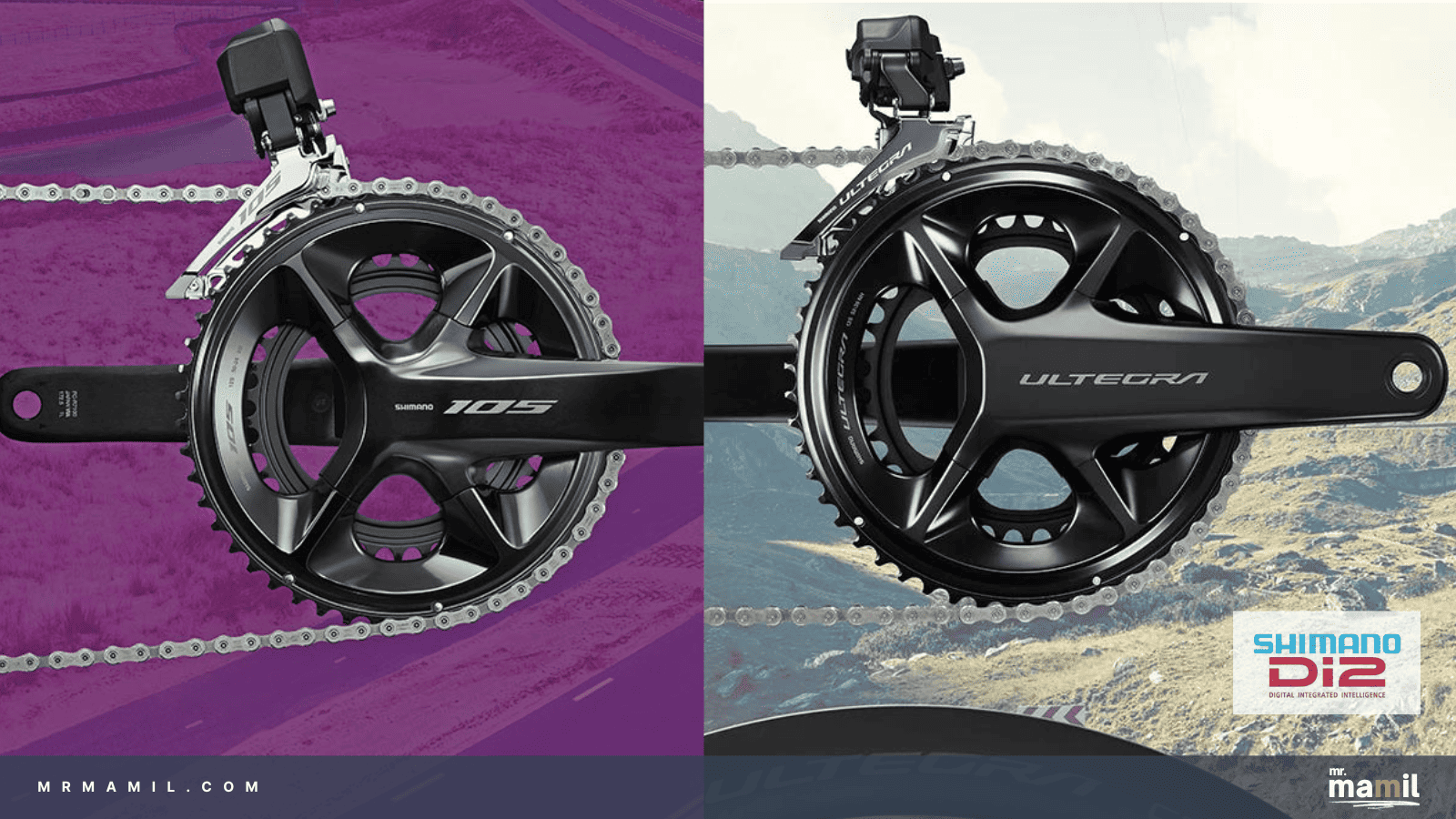
Shimano road groupset ranking
If you’re new to road cycling, here’s how the Shimano groupsets are ranked.
- Dura-Ace is Shimano’s top-tier groupset, the crème de la crème if you will. It’s the lightest and most advanced groupset Shimano offers, and it’s what you’ll find on the bikes of professional cyclists. If you’re looking for the best, this is it.
- Ultegra is a step down from the Dura-Ace, but don’t let that fool you. While it’s a bit heavier and less expensive, its performance is on par with the Dura-Ace. It’s a fantastic option if you’re looking for high performance without the top-tier price tag.
- 105 is the cheapest 12-speed Di2 road groupset Shimano offers. Its performance is close to Ultegra. If you’re looking for a balance between cost and performance, the 105 is a great choice.
Weight comparison
According to Shimano’s specifications, here’s how they stack up.
The total groupset weight for a semi-wireless disc brake, 50/34T chainring, 11-34T cassette setup weighs as below,
- 105 : 2,562g
- Ultegra : 2,374g
| Component | Shimano 105 Di2 | Shimano Ultegra Di2 |
|---|---|---|
| Disc brake levers/shifters (pair) | 423g | 391g |
| Disc brake calipers (pair) | 246g | 246g |
| Disc rotor (pair) | 256g | 236g |
| Rim brake levers/shifters (pair) | n/a | 295g |
| Rim brake calipers (pair) | n/a | 362g |
| Front derailleur | 142g | 116g |
| Rear derailleur | 302g | 262g |
| Crankset (50-34T, 170mm) | 754g | 700g |
| Cassette (11-34T) | 361g | 345g |
| Battery | 53g | 53g |
| Cables (each, 2 required) | 12.5g | 12.5g |
The total weight difference is 188g and may not be as significant as you think. Based on my experience, it’s all about finding the right balance for your needs and preferences, which I’ll discuss in the next sections.
Price comparison
Depending on where you buy the groupsets from, a complete 105 R7150 groupset would cost around $1,900 compared to $2,400, translating to around a 25% price difference.
Groupset features
With the groupset features, it’s not just about weight and price. The real differences lie in the materials used and the advanced functionalities of the components.
Generally speaking, the Ultegra is very similar to Dura-Ace except for the materials used. Dura-Ace components have more lightweight Carbon Fiber Reinforced Plastic (CFRP) parts.
But here’s the kicker; the servo motors and circuit boards used in the derailleurs and shifters are the same for Dura-Ace and Ultegra.
As for 105 Di2, it’s a bit less advanced. For example, the front derailleur is from the previous 11-speed generation model that has been rebranded. But don’t let that deter you. The 105 still delivers reliable performance, making it a great value option.
Wireless vs wired setup
Both shift levers support a wireless setup. The Ultegra disc and rim brake shift levers also support a wired setup.
You’ll need the 4-port junction (EW-JC304) and three additional cables to run a wired setup. With a wired setup, you can increase the main battery’s life by about 50%, eliminate the wake up shift, update the shifter levers’ firmware, and avoid the hassle of replacing their coin batteries.
Shift levers

The 105 (ST-R7170) and Ultegra (ST-R8170) shift levers have the same ergonomic design and functionalities. They support wireless shifting and allow you to adjust the lever’s free stroke and reach. That’s where the similarities end.
Here are their differences.
- Wired setup. Only the Ultegra shift levers support a wired setup.
- Hood buttons. There is no hood button on the 105 shift levers.
- Cable ports. The 105 shift levers have only one port, which can only be used for diagnostics and firmware updates. The Ultegra shift levers have two ports for connecting satellite shifters or a wired setup.
- Battery size. The 105 shift levers require two CR1632 batteries vs. one CR1632 for Ultegra shifters.
Rear derailleurs

The rear derailleur is the heart of the 12-speed Di2 system. It acts as the main junction box and holds the charging port, function button, and LED indicator.
Both derailleurs feature the Shimano Shadow Technology, first introduced in the 11-speed groupsets. With the Shadow Technology, the rear derailleur has a low profile design at the top gear position (smallest cog) for a quieter drivetrain.
The differences lie in the materials used and supported cassette sizes.
- 105 (RD-7150) supports cassettes up to 36T
- Ultegra (RD-8150) supports cassettes up to 34T
The difference is in the total capacity, 41T for 105 and 39T for Ultegra. Better Shifting has an informative article explaining total capacity in derailleurs.
Front derailleurs
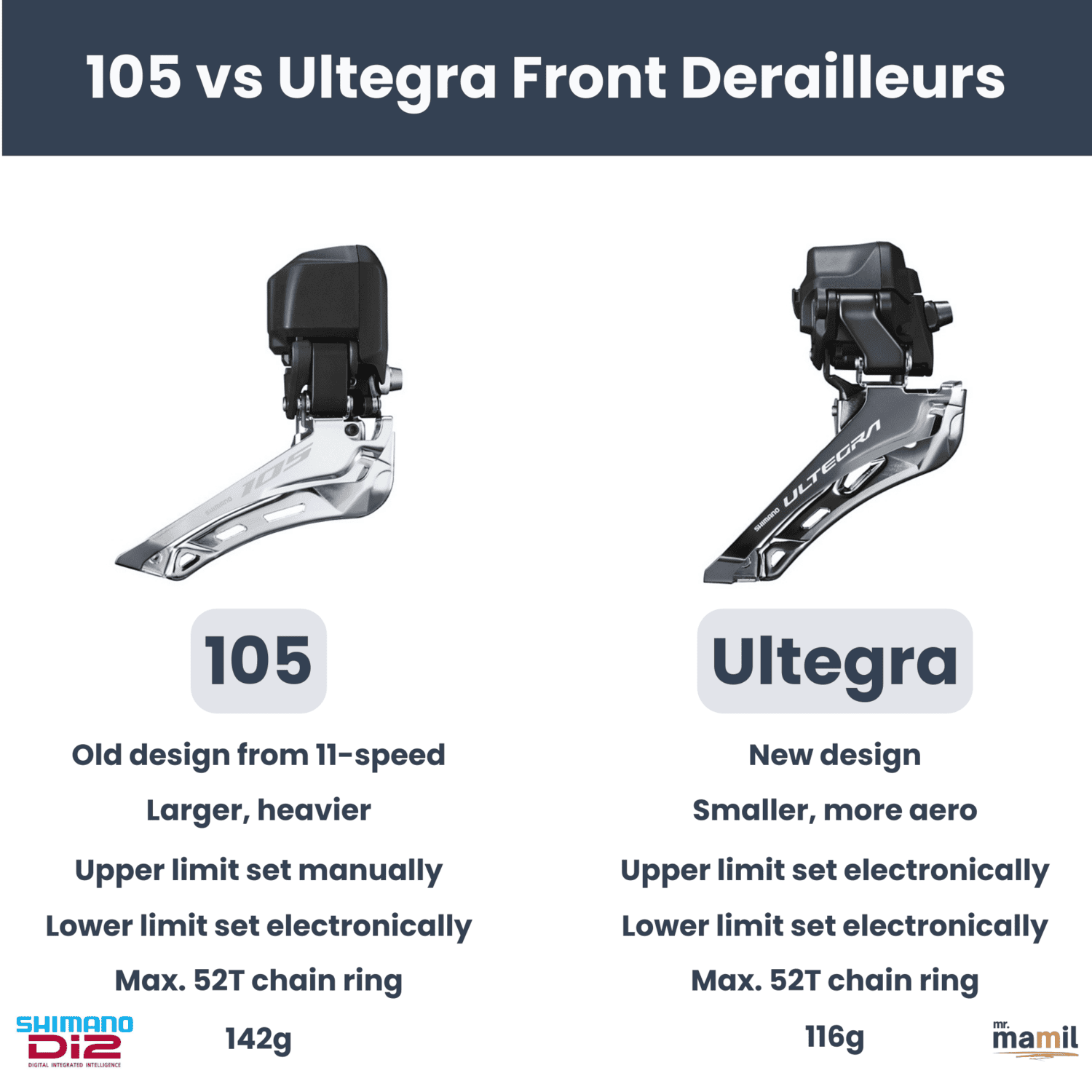
The 105 (FD-7150) is essentially the previous generation’s 11-speed Ultegra front derailleur with newer firmware and 105 logo. Compared to the Ultegra (FD-8150), it shifts (marginally) slower, looks bigger, and is not as aerodynamic and sleek.
An important difference is the limit screws. The upper and lower limits on the Ultegra (FD-8150) are set electronically. For 105 (FD-7150), the upper limit is set manually (via the bolt), and the lower limit is set electronically.
The Ultegra and 105 accept up to a 52T chain ring, although the Ultegra can unofficially accept 54T, too. This is because Shimano doesn’t make a 54T chain ring for Ultegra, which I’ll discuss next.
Cranksets
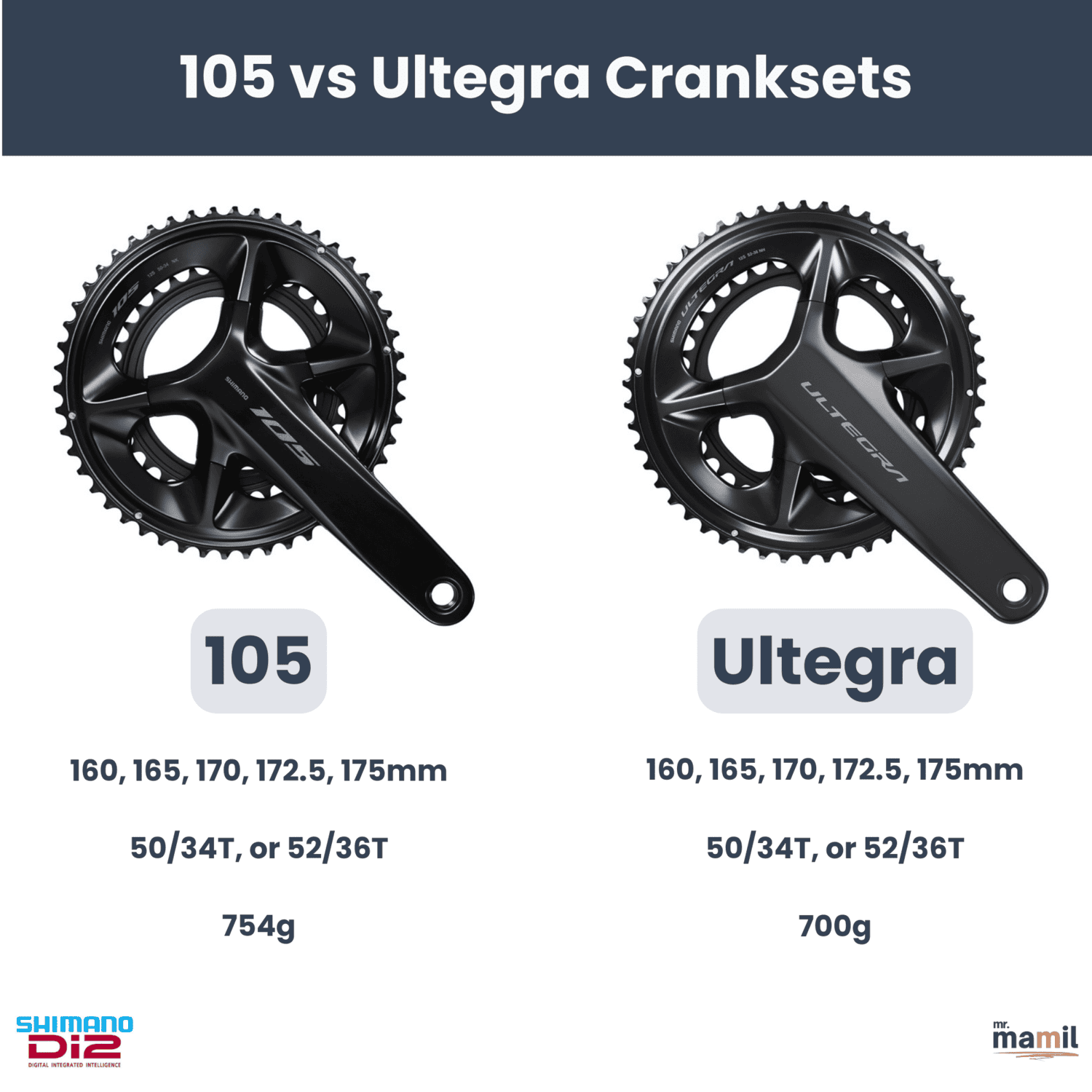
The 105 (FC-7150) and Ultegra (FC-8150) cranksets are available in five lengths: 160, 165, 170, 172.5, and 175mm.
Shimano no longer offers the standard chain ring size (53/39T) for all 12-speed groupsets. There are two chain ring options for 105 and Ultegra;
- 50/34T
- 52/36T
The cranksets have a four-arm attachment, similar to the previous generations. However, the 11 and 12-speed chainrings are not cross-compatible due to the arms’ placement.
Cassettes
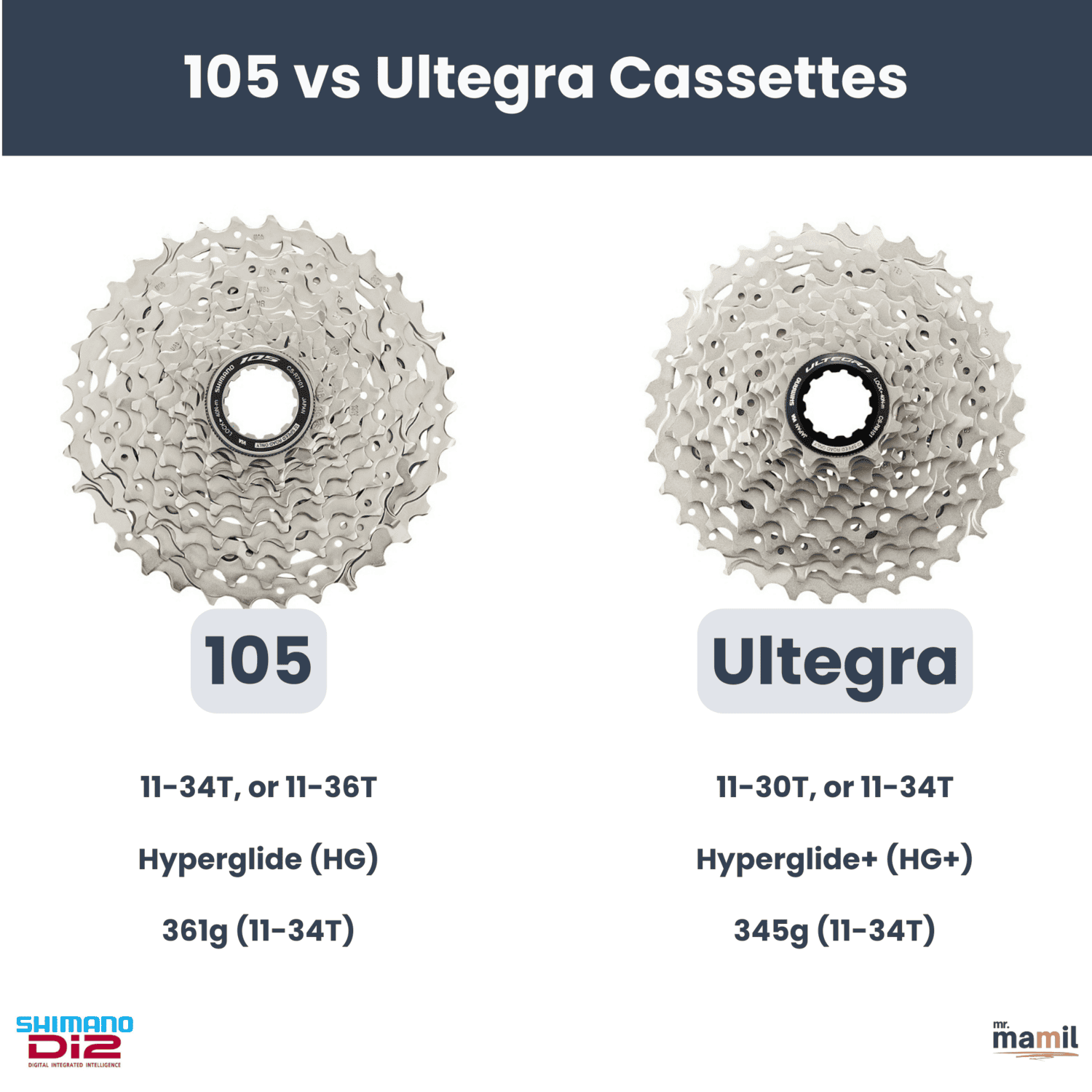
Shimano has streamlined the cassette sizes for its 12-speed groupsets.
The 105 cassettes are available in 11-34T (CS-R7101-12) and a non-series 11-36T (CS-HG710-12) size.
The Ultegra cassettes are available in 11-30T or 11-34T (CS-R8100-12).
The 105 uses the older Hyperglide (HG) technology vs. the newer Hyperglide+ (HG+) on the Ultegra cassette.
- Hyperglide+ (HG+) is a specific cog tooth profile to match the chain for faster shifting, both up and down the cassette, especially under load.
- Hyperglide (HG) is similar, but only for shifting up to a larger cog.
Brakes
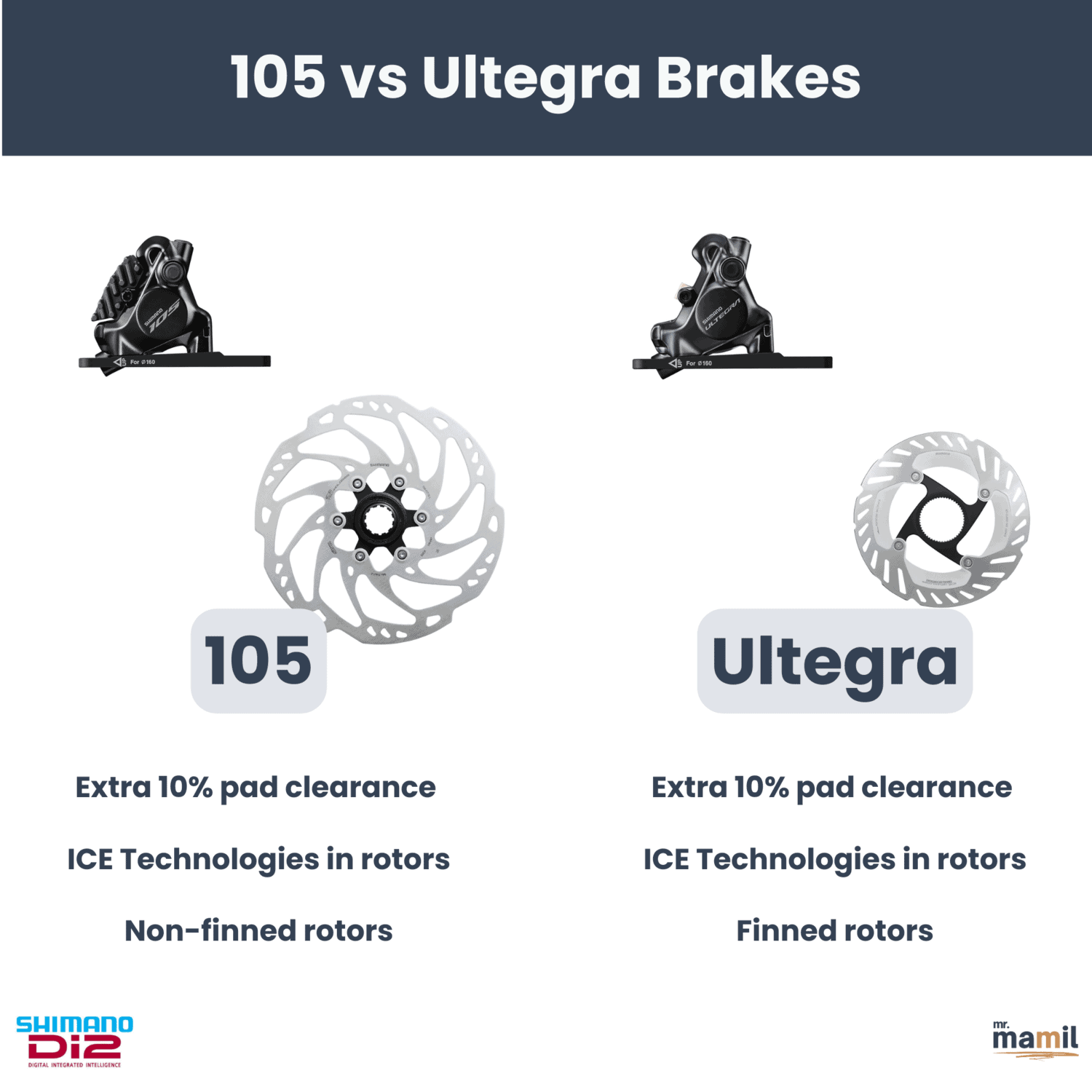
As mentioned briefly above, the 105 only supports disc brakes, while Ultegra supports both rim and disc brakes.
Shimano improved the disc brakes for its 12-speed groupsets, giving the calipers an extra 10% clearance between the pads and rotors. This will help to avoid the notorious rotor rub issue.
The Ultegra disc brakes also feature the Servo Wave technology inherited from Shimano’s mountain bikes range. Servo Wave increases the brake lever’s leverage by reducing the distance it needs to be pulled before the brake pads contact the rotor.
Both 105 (SM-RT70) and Ultegra (RT-CL800) rotors feature the ICE Technologies with a 3-layer design (stainless steel/aluminum/stainless steel) to overcome heat from prolonged braking. However, only the Ultegra rotors have the Freeza cooling fins.
Software functionalities and connectivity
Software-wise, the 105 and Ultegra Di2 have wireless connectivity over Bluetooth LE / ANT, support synchronized shifts, and you can set up and configure them using Shimano’s E-Tube app.
Which one to choose?
This is the ultimate question.
I’ve outlined all the facts, features, and functionalities of both groupsets. Ultimately, it’s up to you to compare them against your needs and budget.
Keep in mind the 105 and Ultegra (and Dura-Ace) components are cross-compatible with each other. So, you’re not locked into any of them.
For many mamils, the 105 is more than enough for everyday riding. You won’t miss out much by going with the 105, except for the Servo Wave technology, where the difference can be felt. In that case, you can consider upgrading the brake levers to Ultegra.
But if you’re a weight weenie like some mamils, then consider the Ultegra. I’ve also seen many riders mix and match to achieve the ideal balance between budget and performance.

Alex Lee is the founder and editor-at-large of Mr. Mamil. Coming from a professional engineering background, he breaks down technical cycling nuances into an easy-to-understand and digestible format here.
He has been riding road bikes actively for the past 12 years and started racing competitively in the senior category during the summer recently.